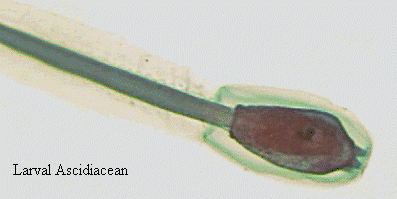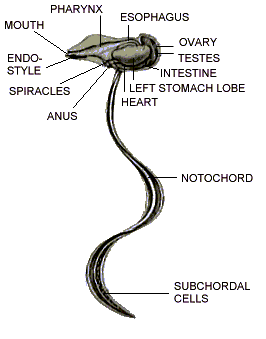 Chordata:
Pikaia.
Chordata:
Pikaia.| Chordata | ||
| The Vertebrates | Chordata |
| Vertebrates Home | Vertebrate | Vertebrate |
|
Chordata
├─Urochordata
│ ├─Larvacea
│ │ ├─Oikopleuridae
│ │ └─┬─Kowalevskiidae
│ │ └─Fritillaridae
│ └─┬─Ascidiacea
│ └─Thaliacea
└─┬─Cephalochordata
└─┬─Haikouella
└─Vertebrata
|
Contents
Overview |
 Chordata:
Pikaia.
Chordata:
Pikaia.
from the Tommotian, perhaps earlier
*: Urochordata + (Cephalochordata + (Haikouella + Craniata)).
Characters: body bilaterally symmetrical; $ single, dorsal, hollow nerve cord, usually with an enlarged anterior end (brain); nerve cord with pairs of nerves branching from it at more or less regular intervals and running to muscles; $ pharyngeal pouches, bars and/or slits (embryologically all the same thing); body or post cranial body if a head is present) segmented, including segmented muscles; $ notochord, a cartilaginous rod running underneath, and supporting, the nerve cord and dorsal to gut; $ muscular tail projecting posterior to anus; three embryonic germ layers and well-developed coelom; ventral heart, with dorsal and ventral blood vessels and closed circulatory system.
Image: Pikaia a possible chordate from the Early Cambrian Burgess Shale.
Note: many of these characters may not be present during some phase of the life cycle.
Links: Animal Diversity Web: Phylum Chordata; Introduction to the Chordata; Phylum Chordata Overview; Chordata; Chordata. The Columbia Encyclopedia, Sixth Edition. 2001; Chordata; biodidac; General Zoology - Phylum Chordata; Phylum Chordata; M17.htm; Chordate-classes; Encyclopedia.com: Chordata. ATW080123.
 Urochordata: = Tunicata) Tunicates. Yarnemia? (a pre-Cambrian form)
Urochordata: = Tunicata) Tunicates. Yarnemia? (a pre-Cambrian form)
from the Jurassic
Chordata: Cephalochordata + (Haikouella + Craniata)) + *: Larvacea + (Ascidiacea + Thaliacea).
Marine suspension feeders; ascidian embryo and larvacean adults have ciliated pharyngeal slits, notochord, muscular tail, dorsal nerve cord directly dorsal to notochord; dual nervous system with different nerves enervating segmented (somatic nerves) and unsegmented (visceral nerves) regions; segmented muscles (myomeres) enervated by dorsal nerve cord; locomotion by contraction of alternate sides as in vertebrates; exhibit some allorecognition (i.e. immune-type response).
Links: Urochordates; Chordata; The Urochordata; Chordata : Subphylum Urochordata; OceanLink; Kennesaw.
References: Swalla et al. (2000).
Image: © 1999 BIODIDAC and used by permission. ATW080123.
 Larvacea: = Appendicularia): Planktonic (0.5 - 5 cm) forms with adult similar to ascidiacean larvae.
Larvacea: = Appendicularia): Planktonic (0.5 - 5 cm) forms with adult similar to ascidiacean larvae.
Recent.
Urochordata: Ascidiacea + Thaliacea) + *: Oikopleuridae + (Kowalevskiidae + Fritillaridae).
Characters: Individuals secrete acellular gelatinous "house" with incurrent, excurrent and caudal openings; incurrent duct has "screens" to keep out large particles and feeding screens or filters (again, acellular and extrasomatic); brushes food particles into mouth with cilia; endostyle secretes mucous to trap food particles; may have pharyngeal slits (respiration?); food passes through U-shaped digestive tract and out anus and excurrent duct; anus and tail are ventro-medial; tail long, with notochord; action of tail and cilia create current for filter feeding; dorsal nerve cord present throughout life; changes in "house" relatively frequent (as short as a few hours); generation time also 1 - 2 days; largely monoecious and protandrous (see the Glossary -- that's what its there for); able to feed on nannoplankton (on the order of 1 µ); non-cellular circulatory fluid and single heart present in some forms.
Links: M20.htm; Blank French); Nice papers on gelatinous zooplankton; gephrokapusa image of Oikopleura; text in Japanese); Urochordates; Z250 2000) - Deuterostome Clade; Earthlife.net; Larvacea.
The Earthlife site has a wonderful plain-language introduction to the Larvacea, with a good diagram. Conversely, BIODIDAC has an excelent diagram (labelled in French), but no text. A Spineless Column by Ronald L. Shimek, Ph.D. Tunicates or Sea ... has a very nice discussion of tunicates generally. A number of sites touch briefly on the Larvacea in evolutionary context, e.g..: Home page and Chordata. References to the literature are available at Pelagic Tunicate References.
Image: Oikopleura from MEER.
References: Swalla et al. (2000). ATW080123.
 Oikopleuridae:
Oikopleura. The "complete" larvacean.
Oikopleuridae:
Oikopleura. The "complete" larvacean.
Recent.
Larvacea: Kowalevskiidae + Fritillaridae) + *.
The "complete" larvacean. The other groups are presumably simplified forms which have disposed of one or more organ systems by reducing their size; very small genome size [S+01]; genes compressed, with introns and intergene regions not similar to vertebrates [S+01].
Note: Seo et al. (2001) expressly refuse to draw the conclusion that the genome is compacted to permit rapid reproduction, because the data is too preliminary. This is the natural conclusion to draw; but, as they note, it may also be that urochordates are less closely related to vertebrates than is normally believed.
Links: FREAKS OF NATURE nice short description of mode of feeding, link to good photos); Study of Genetic Diversity of Eukaryotic Picoplankton (not strictly relevant, but the implications are a bit startling).
References: Seo et al. (2001) [S+01]. ATW050821.
 Kowalevskiidae: Kowalevskia
Kowalevskiidae: Kowalevskia
Recent.
Larvacea:: Fritillaridae + *.
Larvaceans without endostyle, heart or spiracles; body form strongly simplified, with very short life cycle.
Links: RESUMEN; AN52. ATW080123.
Recent.
Larvacea:: Kowalevskiidae + *.
Stomach strongly reduced.
ATW040314.
checked ATW080123.